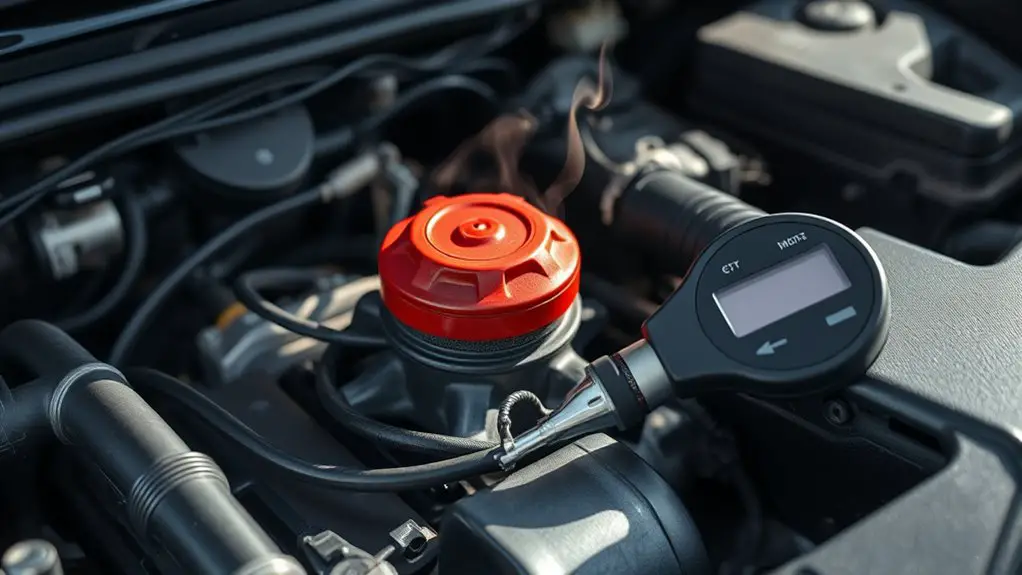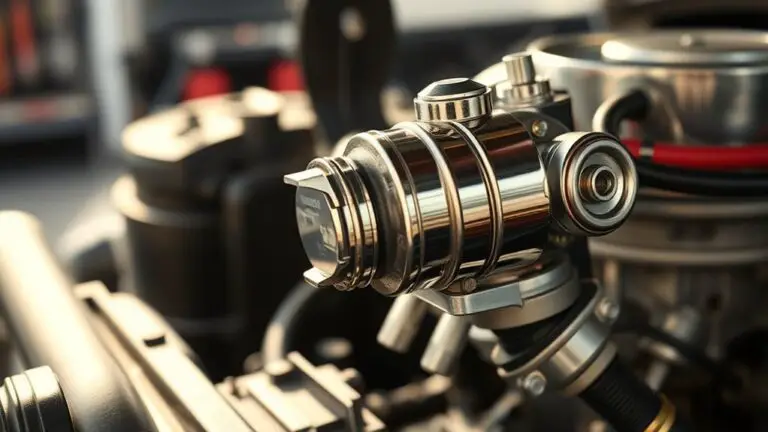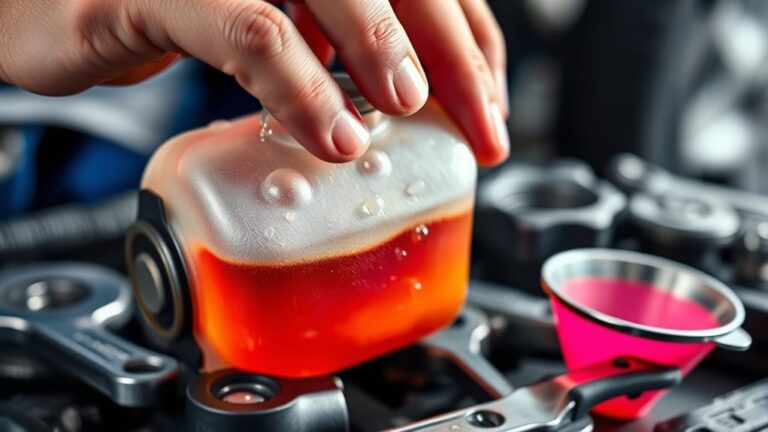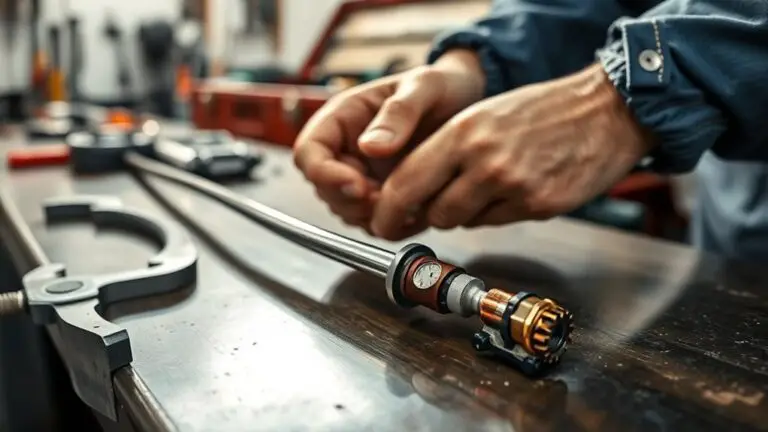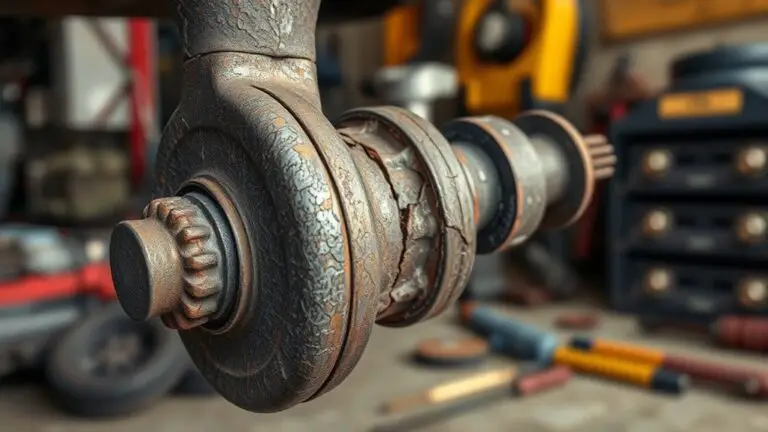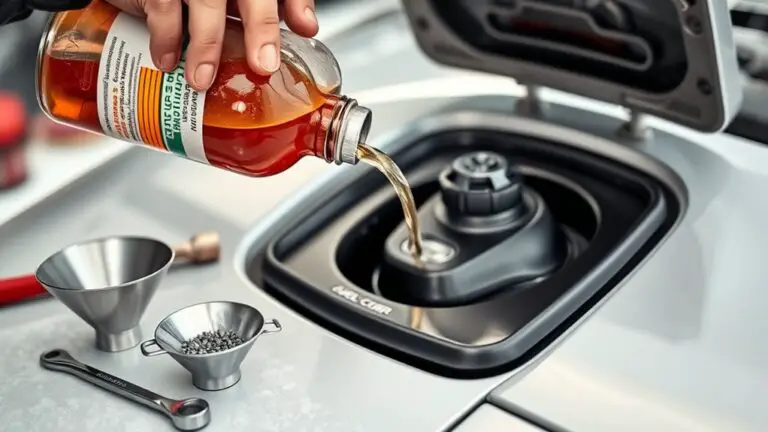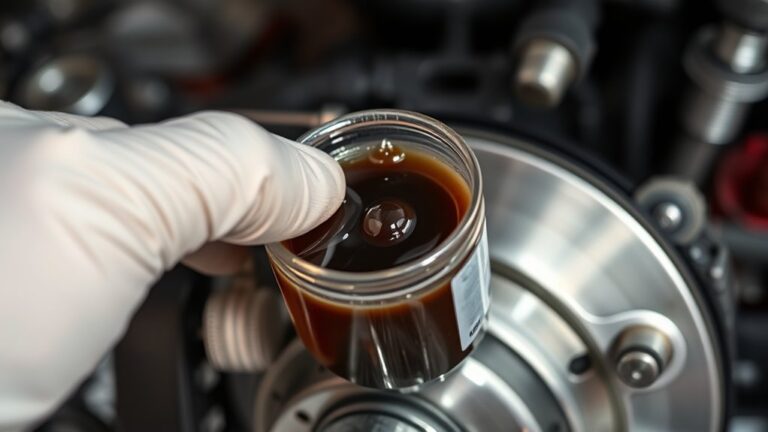How to Diagnose Overheating in a Compact Car Engine
To diagnose overheating in a compact car engine, start by checking the coolant level and condition. Inspect the radiator and hoses for damage or leaks. Evaluate the thermostat’s functionality and verify the water pump is operating efficiently. Analyze the cooling fan’s operation to confirm it activates correctly with temperature changes. Finally, identify any leaks and perform a diagnostic test to gather error codes. There’s more to explore to keep your engine healthy and performing well.
Understanding Engine Overheating

When you notice your compact car’s temperature gauge creeping into the red zone, it is crucial to understand what overheating entails. Overheating occurs when the engine temperature exceeds the normal operating range, which can lead to severe damage. This situation typically indicates a failure within the cooling system, responsible for regulating engine temperature. Several components contribute to this system, including the radiator, coolant, water pump, and thermostat.
If any of these components malfunction, heat can build up, preventing effective heat dissipation. For instance, a low coolant level may result from leaks or evaporation, reducing the system’s ability to absorb heat. Similarly, a faulty thermostat may prevent proper coolant circulation. Understanding these mechanics empowers you to address overheating proactively. By monitoring your engine temperature and ensuring your cooling system’s integrity, you can maintain your vehicle’s performance and avoid costly repairs, allowing you to enjoy the freedom of the open road without worry.
Common Symptoms of Overheating
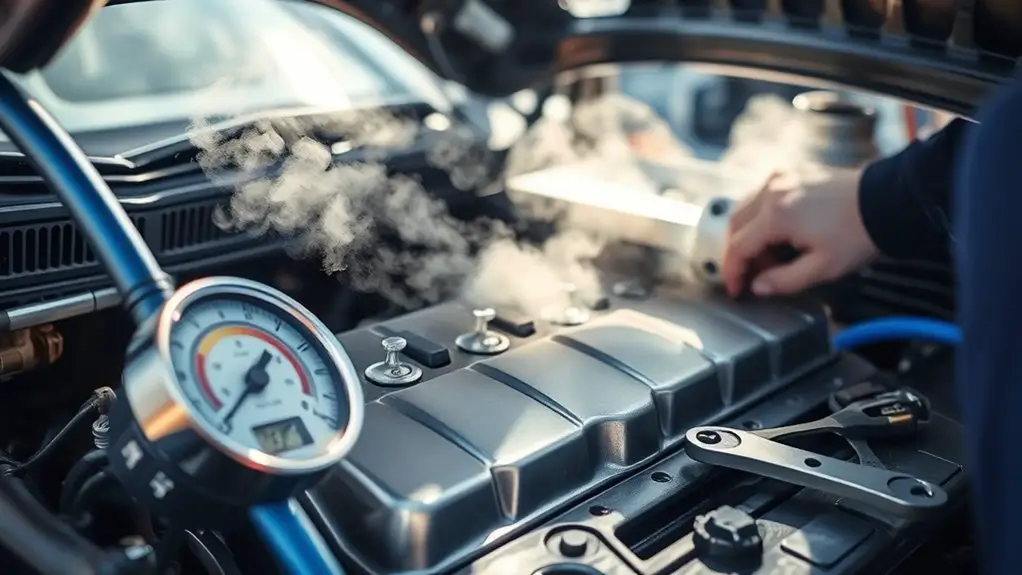
Overheating can manifest through several distinct symptoms that may indicate a problem within your compact car’s engine. Recognizing these signs is essential for maintaining engine performance and preventing long-term damage.
- Temperature Gauge Warning: If the temperature gauge spikes into the red zone, this is a clear indication of overheating, often linked to inadequate coolant levels or a failing thermostat.
- Steam or Smoke: Visible steam or smoke from under the hood signifies extreme overheating, which may result from overheating causes like a broken water pump or coolant leak.
- Unusual Engine Noises: Knocking or pinging sounds can indicate that the engine is running too hot, potentially leading to severe damage if not addressed promptly.
Identifying these symptoms early can help you take corrective action, ensuring your compact car continues to perform efficiently without the risk of catastrophic failure.
Checking the Coolant Level
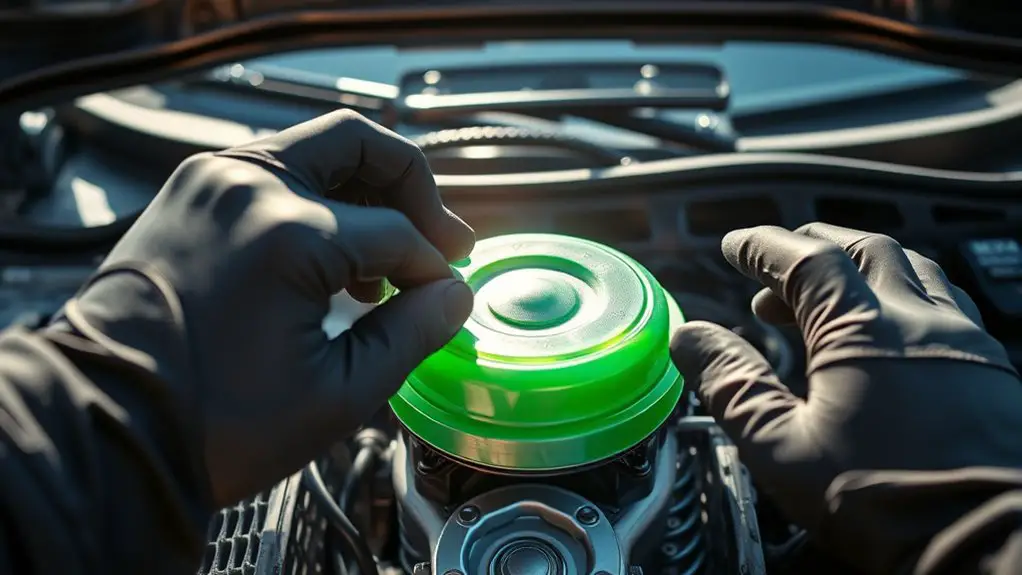
To guarantee your engine isn’t overheating, start by locating the coolant reservoir. Once found, inspect the coolant’s condition and verify its level against the recommended marks. Proper coolant levels and quality are essential for effective engine temperature regulation.
Locate Coolant Reservoir
The coolant reservoir plays an essential role in maintaining ideal engine temperature, so checking its level is crucial for diagnosing overheating issues. To locate the reservoir, refer to your owner’s manual for the precise reservoir location, usually near the radiator or engine. Knowing the correct coolant types is important, as different vehicles may require specific formulations.
- Verify the engine is cool before opening the reservoir.
- Look for minimum and maximum level indicators on the tank.
- If low, add the appropriate coolant type to prevent further overheating.
Inspect Coolant Condition
After ensuring the coolant reservoir is at the correct level, it’s important to inspect the condition of the coolant itself. Look for any discoloration, debris, or cloudiness, which can indicate contamination. Fresh coolant should be a bright, clear color. If it appears rusty or muddy, a coolant flush may be necessary to remove buildup and restore efficiency. Additionally, check for the presence and effectiveness of coolant additives. These additives help prevent corrosion and improve thermal efficiency. If they’re depleted, it’s wise to replenish them or consider a full coolant flush. Regular inspections not only prolong engine life but also safeguard your vehicle’s performance, giving you the freedom to drive without overheating concerns.
Verify Proper Level
Checking the coolant level is essential for preventing engine overheating; ideally, it should be between the “full” and “low” marks on the reservoir. Regular checks can help you avoid costly repairs and guarantee your engine operates efficiently.
- Different coolant types (e.g., ethylene glycol, propylene glycol) may require specific levels for peak performance.
- Monitor temperature gauges while driving; if they indicate high temperatures, recheck the coolant level immediately.
- Consistent coolant levels not only prevent overheating but also extend the life of your engine components.
Make it a habit to inspect coolant levels regularly, adjusting as necessary. By staying proactive, you can maintain your compact car’s health and enjoy the freedom of the road without worry.
Inspecting the Radiator and Hoses
To effectively diagnose overheating issues, you need to inspect the radiator for any signs of damage or corrosion. Additionally, check the hose connections for leaks or wear that could impede coolant flow. These components are critical for maintaining ideal engine temperature.
Check Radiator Condition
A well-functioning radiator is vital for maintaining ideal engine temperature, so evaluating its condition is an important step in diagnosing overheating issues. Start by inspecting the radiator for any signs of damage or corrosion. Regular radiator maintenance can prevent costly radiator replacement down the line.
- Check for leaks in the radiator and around the hoses.
- Make sure the fins aren’t clogged with dirt or debris, which can impair airflow.
- Look for signs of rust or scale buildup inside the radiator.
Inspect Hose Connections
While inspecting the radiator, it’s vital to also examine the hose connections, as any leaks or loose fittings can contribute to overheating. Start by checking for hose wear, which can manifest as cracks, bulges, or fraying. These conditions compromise connection integrity, leading to coolant loss and potential engine damage. Confirm that all clamps are secure and not corroded, as loosened clamps can cause coolant to escape. If you notice any signs of fluid leakage around the hose connections, it’s important to address them promptly. Replace any damaged hoses to maintain peak performance. By confirming that both the hoses and connections are in good condition, you’ll help prevent overheating and prolong your engine’s lifespan.
Evaluating the Thermostat Function
The thermostat plays an essential role in regulating your engine’s temperature, guaranteeing it operates within the ideal range. If your car’s overheating, it’s vital to evaluate the thermostat function. You can start with thermostat testing to check if it’s opening and closing properly. A malfunctioning thermostat can lead to improper coolant flow, causing overheating and potential engine damage.
Consider these points during evaluation:
- Temperature Fluctuations: Watch for erratic temperature readings on the gauge.
- Coolant Leaks: Inspect for leaks around the thermostat housing, which may indicate failure.
- Engine Performance: Notice if your engine struggles to reach peak temperature.
If you find issues during your assessment, thermostat replacement may be necessary. Addressing thermostat problems promptly can save you from costly repairs and guarantee your engine runs smoothly.
Examining the Water Pump
Inspecting the water pump is crucial for maintaining ideal engine temperature and preventing overheating. The water pump circulates coolant throughout the engine, guaranteeing effective heat dissipation. Start by checking for leaks or damage around the pump housing; any signs of corrosion can indicate failure. Listen for unusual noises during operation, which may suggest bearing wear or cavitation issues.
Regular water pump maintenance is essential—consider flushing the cooling system periodically to prevent blockages. If you find the pump isn’t functioning properly, explore pump replacement options that best suit your vehicle’s specifications. Whether you choose an OEM part or an aftermarket alternative, verify compatibility to maintain peak performance. Remember, a well-maintained water pump can greatly extend your engine’s lifespan and enhance overall reliability. By proactively addressing any signs of trouble, you empower yourself to keep your compact car running smoothly and efficiently.
Analyzing the Cooling Fan Operation
How can you be certain your cooling fan is operating effectively? Start by checking the fan speed; it should ramp up when the engine reaches a certain temperature. If it’s not activating, the fan relay might be faulty, preventing power from reaching the fan. You need to inspect these components carefully to verify your engine’s thermal management system is working at peak performance.
- Monitor for unusual noises, which could indicate mechanical failure.
- Test the fan relay with a multimeter to confirm it’s functioning.
- Observe coolant temperature; overheating may suggest inadequate airflow.
Identifying Potential Leaks
Identifying potential leaks in your car’s cooling system is essential for preventing engine overheating. Begin with a thorough fluid evaluation; check the coolant reservoir and radiator for any signs of fluid loss or discoloration. Inspect hoses and connections for cracks, bulges, or worn areas—these are common leak points. A visual inspection can reveal external leaks, but you should also consider using leak detection dye, which can illuminate hidden leaks when exposed to a UV light. Pay attention to the ground beneath your vehicle; any puddles of coolant can indicate a significant issue. Additionally, monitor your temperature gauge while driving; fluctuating temperatures can signal a leak affecting the cooling system’s efficiency. By diligently evaluating these factors, you’ll guarantee your engine stays cool and operational, granting you the freedom to drive without overheating worries.
Performing a Diagnostic Test
While evaluating the health of your vehicle’s engine, performing a diagnostic test is essential for pinpointing overheating issues. Utilizing reliable diagnostic equipment allows you to gather critical data that can reveal underlying problems. By conducting engine diagnostics, you can identify faults that may not be visible during a visual inspection.
- Check for error codes that indicate sensor malfunctions or cooling system failures.
- Monitor real-time engine temperatures to assess if the overheating is consistent or sporadic.
- Evaluate the performance of the cooling system components, such as the thermostat and water pump.
These steps will provide you with a thorough understanding of your engine’s condition. Once you analyze the data from the diagnostic tests, you’ll be empowered to make informed decisions about necessary repairs, ensuring your compact car runs efficiently and maintains your freedom on the road.
Frequently Asked Questions
Can I Drive My Car if the Engine Is Overheating?
You shouldn’t drive your car if the engine’s overheating. Check the temperature gauge; if it’s in the red zone, you risk severe damage. Low engine coolant is often the culprit, leading to overheating. Continuing to drive can cause a costly breakdown or engine failure. Instead, pull over safely, let the engine cool down, and inspect coolant levels. Prioritizing your car’s health means you’ll enjoy more freedom on the road.
How Long Does It Take for an Engine to Overheat?
An engine can overheat within minutes if the cooling system fails. As the engine temperature rises, a malfunctioning radiator, low coolant levels, or a broken thermostat can quickly lead to elevated heat levels. If you’re driving under heavy load or in high temperatures, this process accelerates. Monitoring your engine temperature gauge is essential; if it spikes, you should pull over immediately to prevent severe damage to your engine.
What Causes Engine Overheating in Older Vehicles?
Engine overheating in older vehicles often stems from cooling system failures, like radiator issues. As components age, the radiator may develop leaks or blockages, hindering coolant flow. Additionally, worn-out water pumps or malfunctioning thermostats can prevent effective heat dissipation. If you notice rising temperatures, check these parts first. Regular maintenance can keep your engine running smoothly, giving you the freedom to enjoy your driving experience without unexpected heat-related breakdowns.
Are There Any Warning Lights for Engine Overheating?
Imagine you’re cruising down the highway when suddenly your engine temperature gauge spikes. You might notice warning indicators lighting up on your dashboard, signaling potential overheating. Most vehicles come equipped with a temperature warning light that activates when the engine reaches vital temperatures. If you see this warning, it’s essential to pull over immediately and assess the situation. Ignoring these indicators could lead to severe engine damage and costly repairs.
How Can I Prevent My Engine From Overheating?
To prevent your engine from overheating, guarantee your cooling system’s in top shape. Regular maintenance is essential; check coolant levels, inspect hoses for leaks, and replace the thermostat if needed. Keep the radiator clean and free of debris, and consider flushing the coolant system periodically. Monitoring the engine temperature during drives can also help you catch issues early. By staying proactive, you can enjoy the freedom of a well-functioning vehicle.

